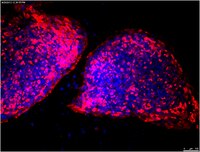Somatic coding mutations in human induced pluripotent stem cells.
Gore A, Li Z, Fung HL, Young JE, Agarwal S, Antosiewicz-Bourget J, Canto I, Giorgetti A, Israel MA, Kiskinis E, Lee JH, Loh YH, Manos PD, Montserrat N, Panopoulos AD, Ruiz S, Wilbert ML, Yu J, Kirkness EF, Izpisua Belmonte JC, Rossi DJ, Thomson JA, Eggan K, Daley GQ, Goldstein LS, Zhang K.
Nature
471
63-7
2010
Zobrazit abstrakt
Defined transcription factors can induce epigenetic reprogramming of adult mammalian cells into induced pluripotent stem cells. Although DNA factors are integrated during some reprogramming methods, it is unknown whether the genome remains unchanged at the single nucleotide level. Here we show that 22 human induced pluripotent stem (hiPS) cell lines reprogrammed using five different methods each contained an average of five protein-coding point mutations in the regions sampled (an estimated six protein-coding point mutations per exome). The majority of these mutations were non-synonymous, nonsense or splice variants, and were enriched in genes mutated or having causative effects in cancers. At least half of these reprogramming-associated mutations pre-existed in fibroblast progenitors at low frequencies, whereas the rest occurred during or after reprogramming. Thus, hiPS cells acquire genetic modifications in addition to epigenetic modifications. Extensive genetic screening should become a standard procedure to ensure hiPS cell safety before clinical use. | 21368825
 |
Direct conversion of human fibroblasts to multilineage blood progenitors.
Szabo, Eva, et al.
Nature, 468: 521-6 (2010)
2009
Zobrazit abstrakt
As is the case for embryo-derived stem cells, application of reprogrammed human induced pluripotent stem cells is limited by our understanding of lineage specification. Here we demonstrate the ability to generate progenitors and mature cells of the haematopoietic fate directly from human dermal fibroblasts without establishing pluripotency. Ectopic expression of OCT4 (also called POU5F1)-activated haematopoietic transcription factors, together with specific cytokine treatment, allowed generation of cells expressing the pan-leukocyte marker CD45. These unique fibroblast-derived cells gave rise to granulocytic, monocytic, megakaryocytic and erythroid lineages, and demonstrated in vivo engraftment capacity. We note that adult haematopoietic programs are activated, consistent with bypassing the pluripotent state to generate blood fate: this is distinct from haematopoiesis involving pluripotent stem cells, where embryonic programs are activated. These findings demonstrate restoration of multipotency from human fibroblasts, and suggest an alternative approach to cellular reprogramming for autologous cell-replacement therapies that avoids complications associated with the use of human pluripotent stem cells. | 21057492
 |
Human embryonic stem cells reprogram myeloid precursors following cell-cell fusion.
Yu, Junying, et al.
Stem Cells, 24: 168-76 (2006)
2005
Zobrazit abstrakt
Here, we examine the ability of undifferentiated human embryonic stem cells (hESCs) to reprogram the nuclei of hESC-derived myeloid precursors following cell-cell fusion. Using an OP9 coculture system, we produced CD45+ CD33+ myeloperoxidase+ myeloid precursors from an Oct4-enhanced green fluorescent protein (EGFP) knock-in hESC line and demonstrated that Oct4-EGFP expression was extinguished in these precursors. Upon fusion with undifferentiated hESCs, EGFP expression from the endogenous Oct4 promoter/regulatory region was re-established, ESC-specific surface antigens and marker genes were expressed, and myeloid precursor-specific antigens were no longer detectable. When the hybrid cells were formed into embryoid bodies, upregulation of genes characteristic of the three germ layers and extraembryonic tissues occurred, indicating that the hybrid cells had the potential to differentiate into multiple lineages. Interestingly, the hybrid cells were capable of redifferentiating into myeloid precursors with efficiency comparable with that of diploid hESCs despite their neartetraploid chromosome complement. These results indicate that hESCs are capable of reprogramming nuclei from differentiated cells and that hESC hybrid cells provide a new model system for studying the mechanisms of nuclear reprogramming. | 16210403
 |
Three monoclonal antibodies defining distinct differentiation antigens associated with different high molecular weight polypeptides on the surface of human embryonal carcinoma cells.
Andrews, P W, et al.
Hybridoma, 3: 347-61 (1984)
1983
Zobrazit abstrakt
Two monoclonal antibodies (TRA-1-60 and TRA-1-81) recognizing distinct cell surface antigens on human embryonal carcinoma (EC) cells were produced and characterized. These antibodies reacted strongly with undifferentiated human EC cells in indirect radioimmunoassays (RIA) and immunofluorescence (IF) assays, but only weakly or not at all with cells derived from pluripotent EC cells differentiating in vitro or in xenograft tumors, nor with other germ cell tumor cell lines that did not also express the typical features of human EC cells. They did not react with murine teratocarcinoma cell lines. A survey of other human tumor cell lines and normal human tissues disclosed that molecules recognized by these antibodies are not confined to human EC cells but that cross-reacting epitopes appear on several neoplastic and normal tissues, although in a different anatomical pattern for each antibody. Both antibodies immunoprecipitated a major polypeptide (apparent molecular weight approximately 240,000) and a minor polypeptide (apparent molecular weight approximately 415,000) from lysates of 125I surface-labeled human EC cells, in this respect resembling another monoclonal antibody, 8-7D, previously described by Blaineau et al. (1,2) However, sequential immunoprecipitation revealed that each of the three antibodies reacted with different molecules of slightly different molecular weights. The epitopes defined by the present antibodies differ from those recognized by the other human EC cell-specific monoclonal antibodies that have been described and provide new markers for studying the differentiation of pluripotent human EC cells. | 6396197
 |












